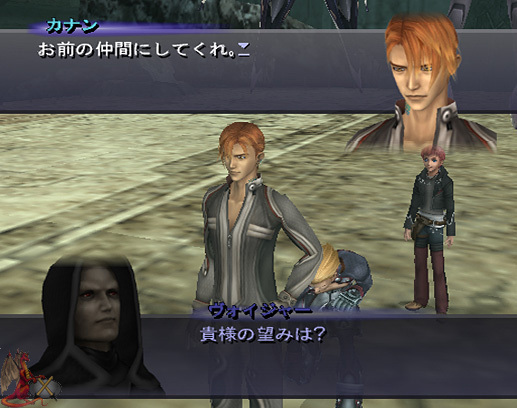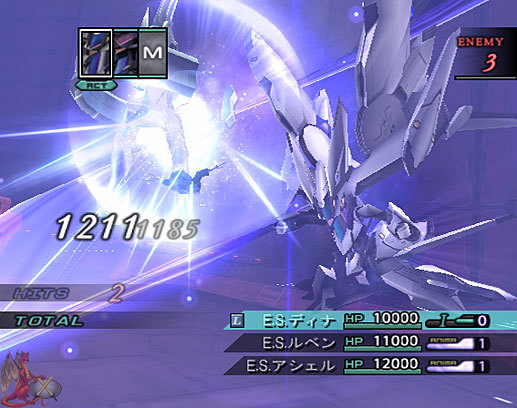|
|

|
BATTLE SYSTEM
|

|
INTERACTION
|

|
ORIGINALITY
|

|
STORY
|

|
MUSIC & SOUND
|

|
VISUALS
|

|
CHALLENGE
|
Easy
|
COMPLETION TIME
|
25-50 Hours
|
|
OVERALL
4.0/5
|
Rating definitions
|
|
|
Though Monolithsoft originally intended its Xenosaga series to span six games, lackluster sales made this possibility ambiguous. Thus, it came as little surprise when they announced that Xenosaga Episode III: Also sprach Zarathustra would be the last installment of the series for the time being. Fortunately, Episode III proves to be a solid conclusion, gameplay and story-wise.
Combat in Episode III combines elements from the first two games while introducing a few new features. As with the first two episodes, enemies are visible in dungeons, and approaching them triggers encounters. However, players can carry up to ten traps to set and detonate to freeze enemies and encounter them to get bonuses such as additional Boost levels. Enemies, in turn, can ambush your party, although players can do the same if they sneak up behind them.
In battle, characters and enemies take their turns evidently depending on speed, with a turn order meter showing who goes when. Why the developers decided that it should run out of icons before refilling in subsequent turns like in the previous chapters is beyond me, although battles, nonetheless, are more enjoyable this time around. Characters no longer have chain attacks requiring various combinations of the face buttons, replaced instead by a tried-and-true attack command. Tech attacks return, as well, though this time, they're normal Ether Point-consuming skills, as are, of course, Ether spells.
 Jr. shows off his volcano at the science fair
Jr. shows off his volcano at the science fair
|
|
The Boost gauge returns, as well, with each character not only able to boost for an extra turn (which requires one boost level), but also use boost levels to perform unique Special Skills. If characters kill enemies such skills, the player will receive extra experience and Skill Points alongside money (shops from the first game return) after battle. Using Special Skills often will also gradually make them more powerful. Enemies have their own Boost gauge and can boost as well, though typically only do so during their turns.
Characters and enemies also have Break gauges, which fill up depending upon the skills both sides of combat use against one another. If someone's Break gauge maxes out, they won't be able to act for two turns, making them more vulnerable to attacks. Certain skills, however, can reduce Break gauges, and it's important during many fights to pay attention to this easily-overlookable, as well as unique, combat aspect.
Individual skill trees for each character return from the first game, as well, with Skill Points gained from battles used to acquire additional skills for each character, with skills coming in sets of four that, when completely acquired, unlock upper-level skills. There are certain items, moreover, that unlock acquirable skills for all characters outside their normal skill trees.
ES battles from the second game return, too, and are very fast. The game's seven main playable characters occupy four ES units, with characters and enemies, as in normal battles, taking turns evidently depending on speed. Players can chain normal ES attacks together depending upon the amount of Energy each ES has, and if an ES kills an enemy yet hasn't used all the attacks the player inputted, that ES will use its remaining attacks against other enemies. ESes can also guard to recover some of their HP, and though the Boost gauge is absent (as are Break gauges), each ES can use Anima skills through gauges built up through constantly attacking enemies; killing enemies with Anima skills will give characters bonus experience and Skill Points.
 "I am a Jedi like my father before me...er, wait..."
"I am a Jedi like my father before me...er, wait..."
|
|
Given that most of Episode III's mechanisms aren't nearly as complex as those in the previous chapters, battles, naturally, are more entertaining. Furthermore, certain accessories can let players instantly see elemental strengths and weaknesses of enemies, and consequently, I found Ether skills to be far more useful this time around. The third chapter is also perhaps the easiest of the trilogy, and I only died late in the game. In the end, there are only a few minor shortcomings, such as the half-assed turn order gauge and that switching characters in combat consumes turns. Overall, though, combat might just appeal to those turned off by the gameplay in the last two chapters.
Interaction is spotless for the most part, aside from some minor lags in the menus, with save points that recover all of your party's HP and EP, easy shopping, a databank, reminders on how to advance, the ability to skip cutscenes, and so forth. Segment Files from the previous chapters return, as well, and an addictive minigame, HaKox, can keep players occupied for a while. All in all, gameplay outside of battle is just as solid as in-battle gameplay.
Given its assimilation of elements from the previous two chapters, Episode III can naturally feel like a retread a times, although it certainly does have some unique tweaks to its gameplay and plenty of new locations in the series' universe.
As with the previous chapters, the story is the main draw to the game, providing plenty of lengthy cutscenes, some backstory, a reasonably-long ending, some good twists, and so forth. The Databank from the first game returns, as well, which really comes in handy considering the complexity of the series' storyline. There are many apparent references to Xenogears, as well. Overall, the story is superb and nicely wraps up Shion and company's arc of the series' plot.
 Seizure-inducing robots
Seizure-inducing robots
|
|
The aurals, though, are actually one of the weaker aspects of Episode III. Though the voicework is superb, much of the music is fairly subdued and unnoticeable at times, with no evident central theme to tie any tracks together, though there are certainly some decent tracks, such as the main boss battle theme and some cutscene pieces. Sound effects are more than passable as they should be in any game of the current generation, though the music, in particular, could've used some work.
The visuals are nice and realistic, with the character designs this time lying somewhere in between the anime styles of Episode I and the more realistic styles of Episode II. Characters are reasonably animated, as well, with decently flashy animations in battle. There is a bit of choppiness at times, though other than that, the graphics are pretty much top-notch for any RPG of the current generation.
Playing time, finally, ranges somewhere from twenty-five to fifty hours, depending upon whether or not players choose to scour every corner of the game's universe. Overall, Episode III is a solid conclusion to the series, assimilating the best elements from its predecessors while omitting most of the bad elements, and being a decent model for future episodes if Monolithsoft ever decides to continue the series. It's sure to satisfy fans of the franchise, and even those who didn't enjoy the first two episodes might just find the third time to be the charm.
Review Archives
|









